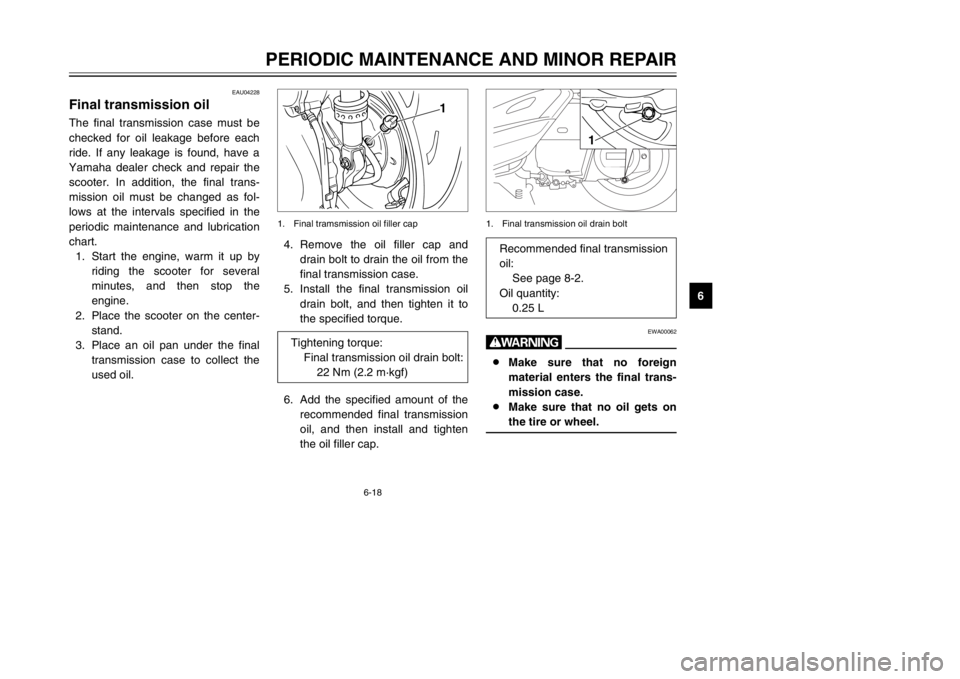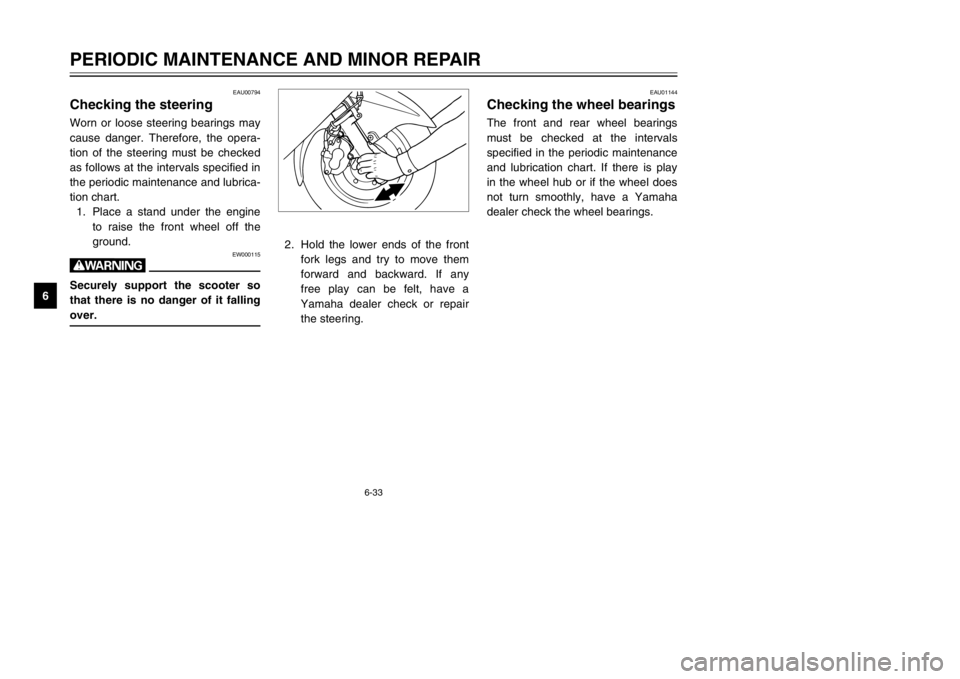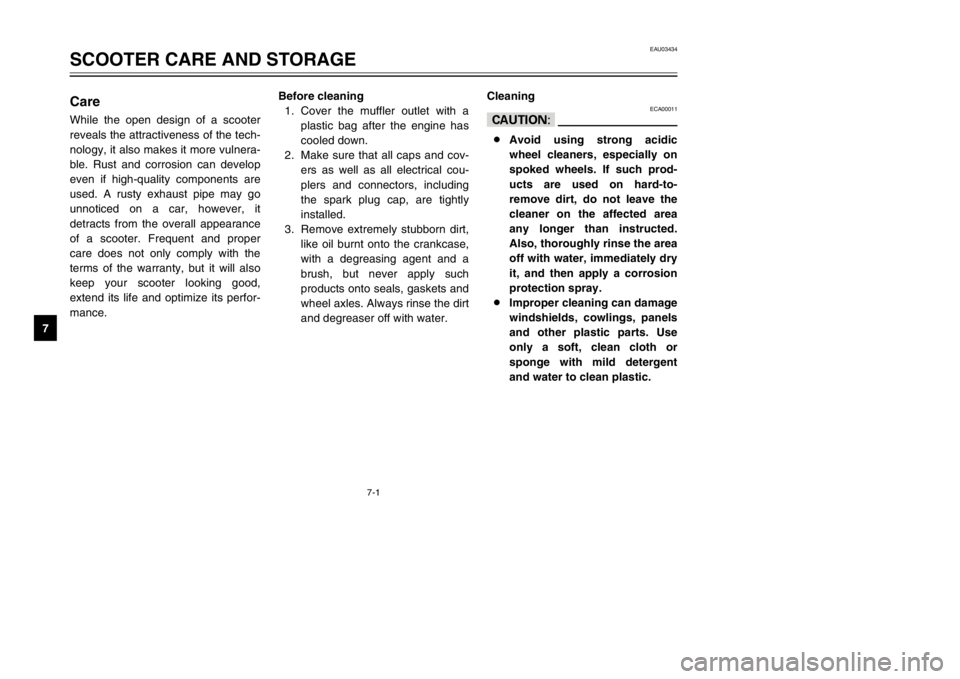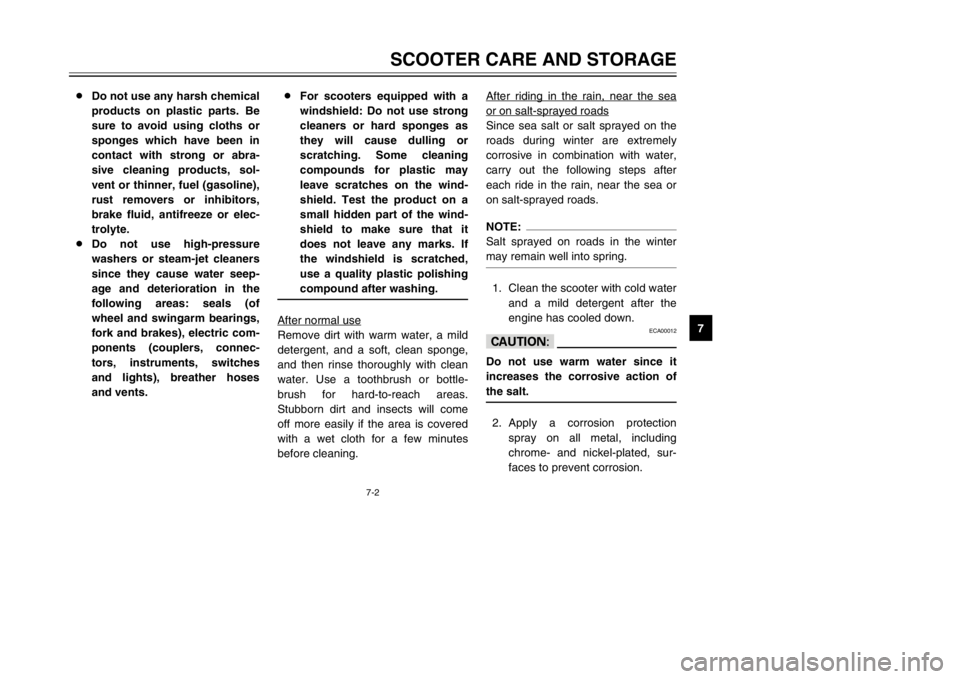2002 YAMAHA MAJESTY 250 wheel
[x] Cancel search: wheelPage 42 of 114

4-2
PRE-OPERATION CHECKS
4
Rear brake•Check operation.
•If soft or spongy, have Yamaha dealer bleed hydraulic system.
•Check fluid level in reservoir.
•If necessary, add recommended brake fluid to specified level.
•Check hydraulic system for leakage.3-13, 6-27–6-30
Throttle grip•Make sure that operation is smooth.
•Check cable free play.
•If necessary, have Yamaha dealer adjust cable free play and lubricate cable and
grip housing.6-23, 6-31
Wheels and tires•Check for damage.
•Check tire condition and tread depth.
•Check air pressure.
•Correct if necessary.6-24–6-27
Brake levers•Make sure that operation is smooth.
•Lubricate lever pivoting points if necessary.3-12–3-13, 6-27, 6-31
Centerstand, sidestand•Make sure that operation is smooth.
•Lubricate pivots if necessary.6-31–6-32
Chassis fasteners•Make sure that all nuts, bolts and screws are properly tightened.
•Tighten if necessary.—
Instruments, lights, signals
and switches•Check operation.
•Correct if necessary.3-2–3-12, 6-37–6-42
Sidestand switch•Check operation of ignition circuit cut-off system.
•If system is defective, have Yamaha dealer check vehicle.3-20–3-22 ITEM CHECKS PAGE
5SJ-28199-E0 1/24/02 6:14 PM Page 41
Page 50 of 114

PERIODIC MAINTENANCE AND MINOR REPAIR
Owner’s tool kit ......................................................6-1
Periodic maintenance and lubrication chart ..........6-3
Removing and installing the cowlings and panel ...6-6
Checking the spark plug ......................................6-12
Engine oil .............................................................6-14
Final transmission oil ...........................................6-18
Coolant ................................................................6-19
Air filter and V-belt case air filter elements ..........6-21
Air flow louver ......................................................6-23
Adjusting the throttle cable free play ...................6-23
Adjusting the valve clearance ..............................6-23
Tires ....................................................................6-24
Cast wheels .........................................................6-26
Adjusting the front and rear brake lever
free play .............................................................6-27
Checking the front and rear brake pads ..............6-28
Checking the brake fluid level .............................6-29
Changing the brake fluid .....................................6-30
Checking and lubricating the cables ....................6-30
Checking and lubricating the throttle grip
and cable ...........................................................6-31
Lubricating the front and rear brake levers ..........6-31
Checking and lubricating the centerstand
and sidestand ....................................................6-31Checking the front fork ........................................6-32
Checking the steering ..........................................6-33
Checking the wheel bearings ..............................6-33
Removing the battery cover ................................6-34
Battery .................................................................6-34
Replacing the fuses .............................................6-36
Replacing a headlight bulb ..................................6-37
Replacing a front turn signal light bulb ................6-39
Replacing a rear turn signal light bulb .................6-40
Replacing a tail/brake light bulb ..........................6-40
Replacing the license plate light bulb ..................6-41
Troubleshooting ...................................................6-42
Troubleshooting charts ........................................6-43
6
5SJ-28199-E0 1/24/02 6:14 PM Page 49
Page 54 of 114

6-4
PERIODIC MAINTENANCE AND MINOR REPAIR
6
8
*Brake hoses•Check for cracks or damage.√√√√ √
•Replace. (See NOTE on page 6-5.)Every 4 years
9*Wheels•Check runout and for damage.√√√√
10*Tires•Check tread depth and for damage.
•Replace if necessary.
•Check air pressure.
•Correct if necessary.√√√√ √
11*Wheel bearings•Check bearing for looseness or damage.√√√√
12*Steering bearings•Check bearing play and steering for roughness.√√√√√
•Lubricate with lithium-soap-based grease.Every 20,000 km
13*Chassis fasteners•Make sure that all nuts, bolts and screws are properly tightened.√√√√ √
14 Sidestand, centerstand•Check operation.
•Lubricate.√√√√ √
15*Sidestand switch•Check operation.√√√√√ √
16*Front fork•Check operation and for oil leakage.√√√√
17*Shock absorber
assemblies•Check operation and shock absorbers for oil leakage.√√√√
18*Carburetor•Adjust engine idling speed.√√√√√ √
19 Engine oil•Change. (See page 3-2 and 6-17 for more information
about the oil change indicator light.)√When the oil change indicator light comes on
(every 3,000 km)
•Check oil level and vehicle for oil leakage.Every 3,000 km√ NO. ITEM CHECK OR MAINTENANCE JOBODOMETER READING (× 1,000 km)
ANNUAL
CHECK
1 10203040
5SJ-28199-E0 1/24/02 6:14 PM Page 53
Page 68 of 114

6-18
PERIODIC MAINTENANCE AND MINOR REPAIR
6
EAU04228
Final transmission oilFinal transmission oilThe final transmission case must be
checked for oil leakage before each
ride. If any leakage is found, have a
Yamaha dealer check and repair the
scooter. In addition, the final trans-
mission oil must be changed as fol-
lows at the intervals specified in the
periodic maintenance and lubrication
chart.
1. Start the engine, warm it up by
riding the scooter for several
minutes, and then stop the
engine.
2. Place the scooter on the center-
stand.
3. Place an oil pan under the final
transmission case to collect the
used oil.4. Remove the oil filler cap and
drain bolt to drain the oil from the
final transmission case.
5. Install the final transmission oil
drain bolt, and then tighten it to
the specified torque.
6. Add the specified amount of the
recommended final transmission
oil, and then install and tighten
the oil filler cap.
1
1. Final tramsmission oil filler cap
EWA00062
w8Make sure that no foreign
material enters the final trans-
mission case.
8Make sure that no oil gets on
the tire or wheel.
1
1. Final transmission oil drain bolt
Tightening torque:
Final transmission oil drain bolt:
22 Nm (2.2 m·kgf)
Recommended final transmission
oil:
See page 8-2.
Oil quantity:
0.25 L
5SJ-28199-E0 1/24/02 6:14 PM Page 67
Page 76 of 114

6-26
PERIODIC MAINTENANCE AND MINOR REPAIR
6
EAU00683
w8Have a Yamaha dealer replace
excessively worn tires.
Besides being illegal, operat-
ing the scooter with exces-
sively worn tires decreases
riding stability and can lead to
loss of control.
8The replacement of all wheel
and brake related parts,
including the tires, should be
left to a Yamaha dealer, who
has the necessary profession-
al knowledge and experience.
NOTE:
The tire tread depth limits may differ
from country to country. Always com-
ply with the local regulations.Tire information
This scooter is equipped with tube-
less tires.FRONT
Manufacturer Size Model
IRC 110/90-12 64L MB67
MICHELIN 110/90-12 64L BOPPER
REAR
Manufacturer Size Model
IRC 130/70-12 62L MB67
MICHELIN 130/70-12 62L BOPPER
EAU03773
Cast wheelsWheelsTo maximize the performance, dura-
bility, and safe operation of your
scooter, note the following points
regarding the specified wheels.
8The wheel rims should be
checked for cracks, bends or
warpage before each ride. If any
damage is found, have a
Yamaha dealer replace the
wheel. Do not attempt even the
smallest repair to the wheel. A
deformed or cracked wheel must
be replaced.
8The wheel should be balanced
whenever either the tire or wheel
has been changed or replaced.
An unbalanced wheel can result
in poor performance, adverse
handling characteristics, and a
shortened tire life.
5SJ-28199-E0 1/24/02 6:14 PM Page 75
Page 83 of 114

2. Hold the lower ends of the front
fork legs and try to move them
forward and backward. If any
free play can be felt, have a
Yamaha dealer check or repair
the steering.
EAU01144
Checking the wheel bearingsWheel bearings, checkingThe front and rear wheel bearings
must be checked at the intervals
specified in the periodic maintenance
and lubrication chart. If there is play
in the wheel hub or if the wheel does
not turn smoothly, have a Yamaha
dealer check the wheel bearings.
6-33
PERIODIC MAINTENANCE AND MINOR REPAIR
6
EAU00794
Checking the steeringSteering, checkingWorn or loose steering bearings may
cause danger. Therefore, the opera-
tion of the steering must be checked
as follows at the intervals specified in
the periodic maintenance and lubrica-
tion chart.
1. Place a stand under the engine
to raise the front wheel off the
ground.
EW000115
wSecurely support the scooter so
that there is no danger of it falling
over.
5SJ-28199-E0 1/24/02 6:14 PM Page 82
Page 97 of 114

7-1
EAU03434
SCOOTER CARE AND STORAGE
7
CareCareWhile the open design of a scooter
reveals the attractiveness of the tech-
nology, it also makes it more vulnera-
ble. Rust and corrosion can develop
even if high-quality components are
used. A rusty exhaust pipe may go
unnoticed on a car, however, it
detracts from the overall appearance
of a scooter. Frequent and proper
care does not only comply with the
terms of the warranty, but it will also
keep your scooter looking good,
extend its life and optimize its perfor-
mance.Before cleaning
1. Cover the muffler outlet with a
plastic bag after the engine has
cooled down.
2. Make sure that all caps and cov-
ers as well as all electrical cou-
plers and connectors, including
the spark plug cap, are tightly
installed.
3. Remove extremely stubborn dirt,
like oil burnt onto the crankcase,
with a degreasing agent and a
brush, but never apply such
products onto seals, gaskets and
wheel axles. Always rinse the dirt
and degreaser off with water.Cleaning
ECA00011
cC8Avoid using strong acidic
wheel cleaners, especially on
spoked wheels. If such prod-
ucts are used on hard-to-
remove dirt, do not leave the
cleaner on the affected area
any longer than instructed.
Also, thoroughly rinse the area
off with water, immediately dry
it, and then apply a corrosion
protection spray.
8Improper cleaning can damage
windshields, cowlings, panels
and other plastic parts. Use
only a soft, clean cloth or
sponge with mild detergent
and water to clean plastic.
5SJ-28199-E0 1/24/02 6:14 PM Page 96
Page 98 of 114

7-2
SCOOTER CARE AND STORAGE
7 8Do not use any harsh chemical
products on plastic parts. Be
sure to avoid using cloths or
sponges which have been in
contact with strong or abra-
sive cleaning products, sol-
vent or thinner, fuel (gasoline),
rust removers or inhibitors,
brake fluid, antifreeze or elec-
trolyte.
8Do not use high-pressure
washers or steam-jet cleaners
since they cause water seep-
age and deterioration in the
following areas: seals (of
wheel and swingarm bearings,
fork and brakes), electric com-
ponents (couplers, connec-
tors, instruments, switches
and lights), breather hoses
and vents.8For scooters equipped with a
windshield: Do not use strong
cleaners or hard sponges as
they will cause dulling or
scratching. Some cleaning
compounds for plastic may
leave scratches on the wind-
shield. Test the product on a
small hidden part of the wind-
shield to make sure that it
does not leave any marks. If
the windshield is scratched,
use a quality plastic polishing
compound after washing.
After normal useRemove dirt with warm water, a mild
detergent, and a soft, clean sponge,
and then rinse thoroughly with clean
water. Use a toothbrush or bottle-
brush for hard-to-reach areas.
Stubborn dirt and insects will come
off more easily if the area is covered
with a wet cloth for a few minutes
before cleaning.After riding in the rain, near the sea
or on salt-sprayed roadsSince sea salt or salt sprayed on the
roads during winter are extremely
corrosive in combination with water,
carry out the following steps after
each ride in the rain, near the sea or
on salt-sprayed roads.NOTE:
Salt sprayed on roads in the winter
may remain well into spring.1. Clean the scooter with cold water
and a mild detergent after the
engine has cooled down.
ECA00012
cCDo not use warm water since it
increases the corrosive action of
the salt.2. Apply a corrosion protection
spray on all metal, including
chrome- and nickel-plated, sur-
faces to prevent corrosion.
5SJ-28199-E0 1/24/02 6:14 PM Page 97